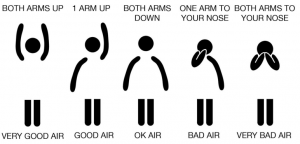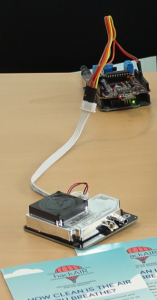Updated in December 2018 with the final project report
Are humans as good as sensors for mapping air quality? Or, in more elaborate words: can we measure air quality through our innate subjective perception? Read on to learn more how these questions are guiding the project “Pollution Explorers”.
What is Pollution Explorers about?
Pollution Explorers is a participatory project exploring air quality issues through people’s subjective perception and wearable technology. The project team hosts workshops in local communities and schools. It is an artist residency led by Ling Tan of Umbrellium in collaboration with hackAIR. Pollution Explorer is building on the results of a long-term initiative by Umbrellium: WearAQ.
As “pollution explorers”, workshop participants take a walk through their neighbourhood to map air quality in two ways: through their own perceptions and through a mobile air quality sensor. Their subjective experience of the air quality is recorded using low tech wearable devices that catalogue their body gestures. The wearables are integrated in a coat (see image above). These coats are easy to put on, for adults as well as for children. Here are the body gestures:

Using machine learning algorithms and correlation techniques, the data from the wearable devices are compared with measurements and datasets relating to air quality from public data sources such as London Air Quality Network and Thingful.net. The data are also compared to the measurements of the mobile air quality sensors that are used during the walk.
Following the walk, participants reflect in a group conversation on how to describe air quality. In a third part of the workshop, they are invited to think about what they can change in their own behaviour to tackle air pollution (see the pledge card below).
Pollution Explorers provides a new way of understanding air quality issues through perceptual experience mapping. By looking at the field of citizen sensing from the viewpoint of wearable technology, the project is adding very valuable additional data and perspectives to the hackAIR project.
Watch the video to see the “Pollution Explorers” in action!
After six workshops, we’ve seen the following:
- Humans are very good at perceiving extreme changes in their environments. While people may not always correctly perceive air quality, they are good at telling if it is better or worse than a location they were at before.
- Children are very sensitive to momentary changes in the air around them, such as a truck or car driving by, and adults tend to be more holistic about how they perceive the air around them, less influenced by momentary changes.
- It is more challenging to describe bad air quality than good conditions. In their conversations during the workshops, participants came up with new words:
- bad air: close, still, smoky, muggy, chokey, exhaust, cementy, gutty, diesel, hot
- so-so air: fragrant, lukewarm, bbq
- good air: pastoral, green, warm, grass-fresh, cool, windy, calm, crisp
- Participating in a workshop about monitoring air quality and citizen sensing supports people to commit to change their behaviour for a certain time period. Here is a pledge by one of the young participants:

Interested in reading more about the learnings of the Pollution Explorers project? Here is a project report, written by Ling Tan.
Pollution Explorers in pictures








 _________________________________________________________________
_________________________________________________________________
Pollution Explorer is an artist residency led by Ling Tan of Umbrellium in collaboration with hackAIR, funded by Vertigo STARTS, supported by FutureEverything. Photo credits for all images in this post: Umbrellium.
















 Send us a picture of the sky where you are currently spending your summer – using the
Send us a picture of the sky where you are currently spending your summer – using the 